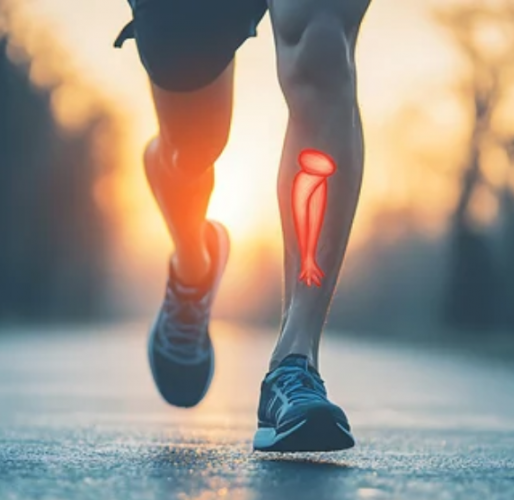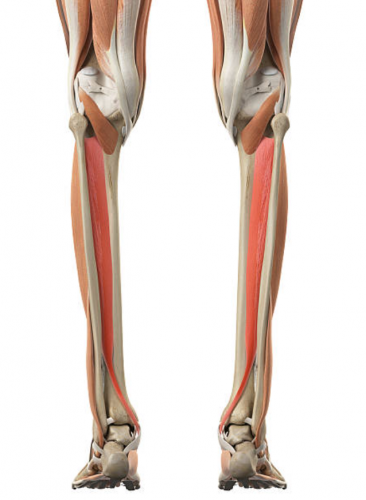Tibialis Posterior – Shin Pain from Running

Anatomy
The Tibialis Posterior (Tib Post) originates on the medial (inner) surface of the posterior (behind) Tibia (large lower leg muscle). It also has minor attachments to the fibula (smaller bone in the lower leg – on the outside) and to the interosseous membrane (fascia that lies between the tibia and fibula). Hence the Tib Post begins deep and medial to your lower leg muscles (gastrocnemius and soleus). It then descends down the medial shin, where it becomes tendon (a flat type sheet of tendon) that travels behind your medial malleolus (inside ankle). It then attaches to a number of little bones in the arch of your foot, predominantly your navicular, then other bones in that area of your foot.

Function
The Tib Post is a running necessity. Although the basic Action of the Tib Post is to plantar flex (point the toe) and invert the ankle (turn the ankle inward), the importance to running is it’s ability to sustain the longitudinal arch of the foot (stops too much pronation – flat foot). Everyone needs to pronate as a normal part of your running gait but too much pronation or pronating too fast, without control, will eventually cause problems. Your Tib Post helps control the rate of pronation as well as the amount of pronation.
Pathologies/Injury
Too much pronation or increased rate of pronation is attributed to many lower leg and foot injuries. One very well known to runners is medial tibia stress syndrome or the ‘shin splints’ (old fashioned term). If the Tib Post is not functioning correctly, it’s attachment to the Tibia can ‘pull’ on the boney surface (periosteum) causing an inflammation of this tissue and hence, shin pain. If the Tib Post is over active it may cause this condition – to tight. Interestingly, if the Tib Post is under active it may also cause this condition as the foot will over pronate and pronate at a rapid rate, causing excessive tension on the medial shin. Hence, the Tib Post should be maintained in a healthy state to avoid both over and under activity.
Another common condition for this muscle is tendonitis (tendon inflammation) and tendinosis (tendon degeneration). This begins as a mild ache behind the medial malleolus (inside ankle bone) that warms up with running but returns after rest and in the morning. As this progresses it can become a sharp pain behind the inside ankle bone that will stop you from running. Pain can sometimes be felt at the attachments of the Tib Post on the Navicular or in the arch of the foot. Swelling may be seen behind the inside ankle bone. In this situation, your acute inflammatory care should take place. Consult your health advisor for ‘what to do’.

Self Treatment
Self Treatment for this condition comprises of self massage to the muscle belly about the tibia attachment and Tibialis Posterior strengthening exercises.
Self massage attempts to reduce any fascial adhesions (fascia surrounds the muscle like glad wrap and this can become ‘stuck’ to surrounding structures) that may be occurring with the periosteum (boney surface) of the tibia and other musculature. This is achieved by creating a shear force (a force that slides one fascial sheet over another) with your fingers over the medial (inside) shin. If you cross the affected leg over the other leg (while you are sitting) you have easy access to your medial shin. Make sure the foot dangles over you other leg to allow the Tibialis Posterior to be on mild stretch. Using your thumb (no lubricant), slide your thumb slowly from just above the ankle towards your knee – your thumb is directly behind the tibia, just touching the surface of the tibia. The pressure is not straight down into your leg but at an angle of approximately 15 degrees into the muscle towards your knee. This will create enough shear force to mobilise any adhesions as you run across them. When doing this, the sensation may be a burning feeling, this is normal and desirable! A combination of slight ache and burning is best. This suggests you are affecting the fascia close to the muscle belly and tibia interface. About 8 slow slides should be enough in any one session.
Secondly, you can start your thumbs on the tibia in the same position above – no lubricant. Slowly allow your thumbs to fall off the tibia onto the softer muscle tissue. When you reach this, imagine you are trying to push the muscle away from or off the bone, again creating that burning and/or aching feeling. Hold at this point for 5 seconds, literally stretching the fascia from the boney surface and allowing freedom of movement. Move from the base of the tibia (just above your ankle) towards the knee, stopping every few centimeters use this technique. Don’t avoid the sore bits as these are the probable areas of concern.
Thirdly, and this time with some lubricant if you wish, glide your thumb from just above the ankle towards your knee, working deep into the muscle belly. Not so deep as to cause uncomfortable pain, but certainly deep enough to feel the pressure is achieving something! Ten glides just medial to the tibia (2-3cm from tibia – to the inside) will be ample in any one session.
Now strength of the Tibialis Anterior. There are many opinions on just how to strengthen this muscle. This is the author’s version and by no means the best or most correct. When the mid foot begins to collapse during running/walking without the adequate braking forces from the Tibialis Posterior, problems begin to occur. Hence, we need to re-educate the Tibialis Posterior to fire when necessary. This process is best taught in a one on one clinical setting, but for beginners, try this below:
- Sit on the edge of a chair (bum on edge of chair) with your arms resting on your knees.
- Begin the exercise by raising the arch of the affected foot. Sounds easy but may take some time to fire it up. Use your good side (if you have one..) to get the idea
- Once the arch is raised, gently push your big toe joint into the floor without losing the arch in your foot. Still with me?
- Now keeping the above two points sustained, now wiggle your big toe. Hard? Very. This is important as it helps isolate the Tibialis Posterior muscle rather than using your flexor hallicus (big toe flexor) to hold your foot in this high arch position. This may take some practice
- If you are still with me, now lean forward off your chair (slightly) to put some weight on your foot. Keep the arch! Don’t allow your big toe to dominate the stability either – keep it loose.
- Tough? Once mastered you will wonder why you thought it was difficult. This is the first step to rehabilitating your Tibialis Posterior
There are numerous taping techniques you can use yourself while your tib post is not functioning correctly. These are best taught by your health professional.
Summary
The Tib Post is a small but very important foot stabiliser in running and walking. If it becomes tight or weak, it will eventually cause problems about that area, either directly to it’s own tendon or to the shin or medial arch of the foot. Keep it healthy with regular self massage and strengthening exercises.
Happy running.